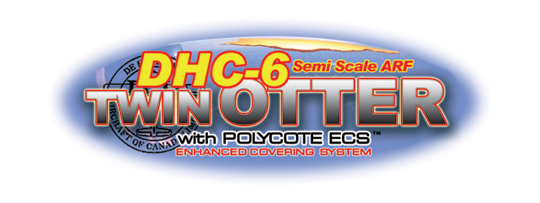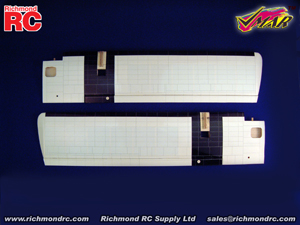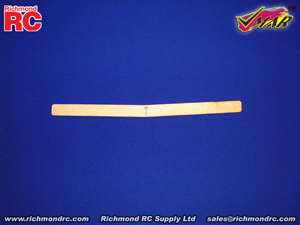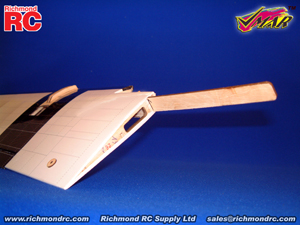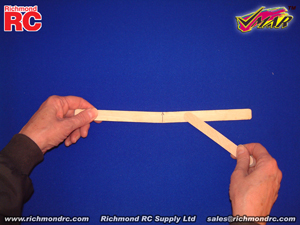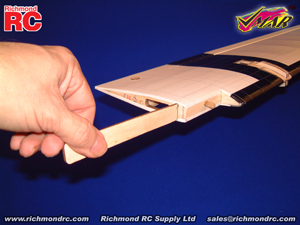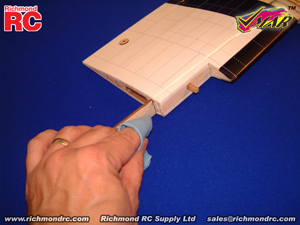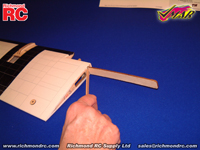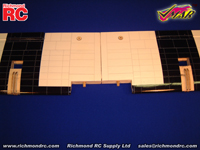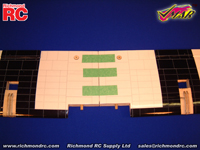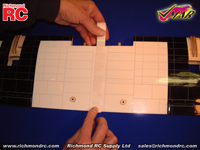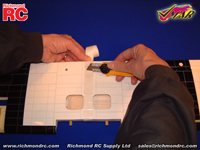| 1. VMA-T210X Twin Otter 09-15 ARF ECS Electric - Various Colors |
Technical Information related to the VMAR Twin Otter ARF ECS.
|
| Notification Service - Subscribe Now |
For automated update notifications please register as a Priority Response member and subscribe to our Priority Response Notification Service.
|
| 1.1. VMA-T210X Twin Otter 09-15 ARF - READ ME FIRST |
PLEASE READ ME FIRST BEFORE PROCEEDING TO ASSEMBLE OR OPERATE THIS PRODUCT
|
| LIABILITY DISCLAIMER & COPYRIGHT NOTICE |
LIABILITY DISCLAIMER The authors and/or suppliers and/or disseminaters of this information and/or product expressly disclaim any warranties or representations, either expressed or implied, including but not limited to implied warranties of fitness, accuracy, timeliness or applicability of the information and/or product provided here. In no event will the authors and/or suppliers and/or disseminaters of this information and/or product have any obligation arising from contract or tort, for loss of revenue or profit, or for indirect, special, incidental, consequential or other damages of any sort arising from this information and/or product. In using this information and/or product, the user accepts all responsibility for and all liability associated with such use. PROCEEDING WITH THE USE OF THIS INFORMATION AND/OR PRODUCT INDICATES AGREEMENT WITH AND ACCEPTANCE OF THE LIABILITY DISCLAIMER.
|
| Please Note the following Caution |
CAUTION A Remote Control (RC) model aircraft is not a toy. It is a flying model that functions much like a full size airplane. If you do not assemble and operate model aircraft properly you can cause injury to yourself and others and damage property. DO NOT FLY a model aircraft unless you are qualified. You are ultimately responsible for the mechanical, aeronautical and electrical integrity of any model you fly and all of the components that make up the model including but not limited to the airframe itself, control surfaces, hinges, linkages, covering, engine, motor, radio, servos, switches, wiring, battery and parts. Check all components before and after each flight. It is essential that you act with the clear understanding that you are solely responsible for all aspects of the model at all times. DO NOT FLY until it is right.
|
| 1.1.1. VMA-T210X Twin Otter 09-15 ARF - General Information |
|
| COPYRIGHT |
Copyright Richmond RC Supply Ltd. All rights reserved.
|
| Tips for Avoiding Common Problems |
We have supplied thousands and thousands and thousands of model aircraft in the past 20 plus years. We're not bragging! We tell you this to give some credibility to our suggested list of tips that follow. In talking to modelers around the world, here is what we have found is the key to... AVOIDING 90% of PROBLEMS that can arise:
|
| 1.1.2. VMA-T210X Twin Otter 09-15 ARF - Supplement to the Manual |
|
| 1.1.2.1. VMA-T210X Twin Otter 09-15 ARF - Electric Power - Options |
Question: My VMAR VMA-T210X Twin Otter 09-15 ARF uses two motors. What do you recommend for a power system?
Answer: We have a couple of options for you to consider:
1) Our VMAX Power Module for the Twin Otter is #VMM-T210XPM1. This consists of two of our VMAX Brushless Motors (#VMC-120B15VC) and two of our VMAX Electronic Speed Controls (ESC) (#VMC-120B15VC). Each motor and ESC has been factory mounted to a power pylon ready to mate with the wing.
2) Our VMAX Power Pack for the Twin Otter (#VMM-T210XPP1) contains the Power Module plus a LiPO battery pack, parallel wiring harness, receiver throttle Y harness and propellers. .
Both of these options have been tested with the Twin Otter and help you get into the air quickly and stay there!
|
| 1.1.2.2. VMA-T210X Twin Otter 09-15 ARF - Electric Power - Wiring | |||||||||||||||
Question: My VMAR VMA-T210X Twin Otter 09-15 ARF uses two motors. How should I wire these up so that I can control them from the single throttle channel on my receiver?
Answer: The simplest solution is to use our VMAX Power Pack which comes with brushless motors, electronic speed controls (ESC), battery pack, propellors etc and includes a custom made Wiring Harness Set for the Twin Otter power and control system. The Power Pack for the Twin Otter is #VMM-T210XPP1.
If you have your own motors, servos, speed controls etc that you intend on using in the VMAR Twin Otter the manufacturer of these electric components is your best bet for advice on operating in a Twin Power configuration. The Wiring Harness Set for the Twin Otter (#VMA-T210XWHS) is available as an aftermarket accessory and in most installations will make it much easier to work with the VMAX Power Module, third party motors, speed controls and servos.
If you have purchased the VMAX Power Pack for the Twin Otter (#VMM-T210XPP1) please follow the installation instructions that come with the Power Pack. The VMAX Power Pack will save you hours and hours of time and greatly reduce the chances of making an expensive mistake.
If you are using third party power components, follow their instructions. In the absence of specific information from the manufacturer here are some general tips that may assist you. Remember, without specific information from the supplier of your Motors and ESC, you run the risk of doing something wrong and such booboos are usually expensive. Use our tips with this in mind. We can't verify that these tips will work with third party equipment and strongly encourage you to obtain information from the manufacturer of your Motors and ESC.
Footnote: There are some dual ESC's that enable you to control two Brushless motors from one ESC. These eliminates the need for a second ESC and may make the installation of third party components simpler. If you are using a dual ESC, ensure that you follow the manufacturers instructions regarding wiring and operations.
|
| 1.1.2.3. VMA-T210X Twin Otter 09-15 ARF - Wing - One Piece or Two? |
Question: My VMAR VMA-T210X Twin Otter 09-15 ARF refers to a one piece wing. The Twin Otter I received has a two piece wing. What's the story here? Answer: In some markets, shipping carriers such as UPS charge an additional surcharge for longer boxes. In these markets we have reduced the length of the box by shipping the wing in two pieces in order to save the end consumer from having to pay surcharges on freight. Additional Information: If your wing was shipped in two pieces, use the wing joiner and 30 minute epoxy to join the wing halves. A roll of wing joint tape has been supplied to seal the joint after the epoxy has cured. USE ONLY 30 MINUTE EPOXY when joining wing halves.
A subsequent article provides detailed instructions for joining the halves of two piece wings.
|
| 1.1.2.4. VMA-T210X Twin Otter 09-15 ARF - (Stage 0) Wing Assembly - Joining the Wing Halves | |||||||||||||||||||||||||||||||||||||||||||||||
| |||||||||||||||||||||||||||||||||||||||||||||||
| 1.1.3. VMA-T210X Twin Otter 09-15 ARF - Important Information |
|
| COPYRIGHT |
Copyright Richmond RC Supply Ltd. All rights reserved.
|
| 1.1.3.1. VMA-T210X Twin Otter 09-15 ARF - Covering |
This model uses POLYCOTE ECS Covering |
| POLYCOTE ECS - Care & Maintenance - Quick Tips |
|
Question: Do you have any pointers regarding the Care & Maintenance of POLYCOTE ECS? Answer: Yes we have this Summary of Quick Tips. See www.richmondrc.com ( Enter Site > Support Services > Knowledge Base then Search on "Covering") for an expanded explanation of each Tip. Polyester offers the best in covering performance and as with any new modern technology, the maintenance methods may be different than those you used with your older covering. This is NOT Monokote or Solarfilm, its different. If you have used ORACOVER or ULTRACOTE you will have some experience with working with POLYESTER as a covering material. Here is our Summary of Quick Tips related to POLYCOTE ECS covering.
|
| 1.1.4. Support |
On Line, eMail, Fax, Phone, Mail |
| We offer the Best in Support Services. |
We back up our products and our customers with the best support services available. From our industry leading Knowledge Base to information about your Shipment, we've got you covered!
To access our Support Services please:
Your Choice of Support Services that Work for You:
|
| 1.1.4.1. Contact Us |
For Sales and other Inquiries |
| Support - Contact Us - Reach our Sales Department by eMail, Fax, Phone or Mail |
Technical Inquiries: Please review the information provided in our Knowledge Base. After checking our Knowledge Base, if you need further assistance please use our Submit A Question service to get a response within 2 Business Days.
Sales Inquiries: Please note that our Sales Department personnel are trained and dedicated to:
Their depth of technical knowledge is about on par with what is shown in our printed sales literature. In most cases, they are working from the same printed advertisements or content from our web site that you are. Asking sales personnel to confirm the size, color and availability of a product is well within their capabilities. However, asking detailed questions about technical issues is not.
Buy our Products:
For All Other Inquiries... please consult the following resources:
|
| 1.1.5. Keep Up to Date |
Check Frequently for Updates |
| Support - Stay Current - Check Frequently for Updated &/or Additional Information |
This information is subject to change without notice. When viewing this information in a printed form the printing date will be visible in the lower right corner. Check frequently for updates &/or Additional Information.at www.richmondrc.com, > Enter the Site, > Support Services, follow the links to our Knowledge Base. Review the Table of Contents and search for the name and/or part number of this product.
For automated notification of changes to information contained in our Knowledge Base please register as a Priority Response member and subscribe to our Priority Response Notification Service.
|
| 1.2. VMA-T210X Twin Otter 09-15 ARF - Additional Information |
In general "Additional" Information is:
Subject to the Conditions of Use, please review the attachments and related articles listed below. |
| COPYRIGHT |
Copyright Richmond RC Supply Ltd. All rights reserved.
|
| 1.2.1. VMA-T210X Twin Otter 09-15 ARF - Aileron Control Rod Length |
Question: The aileron control rods that run from the servo to the aileron control horn on my VMAR Twin Otter appear to be slightly too long. What should I do?
Answer: The Twin Otter wing has been produced in several different configurations depending on the market area. Early production runs shipped to Europe and the UK used a one piece wing. Later production runs and all shipments to North America used a two piece wing. The aileron control rod length is adjustable to fit the wing that you have.
For each aileron: 1) Ensure that your servo is mounted correctly and that the servo arm can rotate freely the way you have installed it. Center the servo arm so that it lies parallel to the wing trailing edge. 3) Install the control horns on the ailerons. Tape the ailerons into a neutral position as explained in the manual. 4) If you find that the aileron control rods are too long, use a ruler to measure how much shorter you need to make the rod.
5) If in any doubt about the security of the coupling, unthread the clevis and wick thin CA into the coupling between the stud and the plastic tube. Do not get CA into the clevis threads. |
| 1.2.2. VMA-T210X Twin Otter 09-15 ARF - Extra Hardware Items |
Question: I have completed the assembly of my VMAR Twin Otter and I have a few extra hardware items such as horns, screws and wing bolts. What are these for?
Answer: We usually include a few extra horns and wing bolts with all VMAR ARF's. You may also find a spare clevis and a couple of small screws depending on the model. These are free and intended to help you out if you drop or misplace one of these small items. If you have followed all of the assembly steps, completed your model, tested that your radio and control surfaces all move correctly, tug tested everything twice, just put any of extra hardware pieces in one of the bags and set it aside as spares just in case you need them later on. Don't throw anything out, you just never know when that screw, horn or nut may be needed!
|
| 1.2.3. VMA-T210X Twin Otter 09-15 ARF - Pilots - What sizes fit? |
Question: Can pilots be installed in the VMAR Twin Otter? If so what are the dimensions that I should keep in mind when selecting pilots?
Answer: Yes pilots (2) can be installed in the VMAR Twin Otter. The factory seats and shoulder harnesses are installed and the seats have a flexible back that facilitates installation of after market pilots working from inside the main radio bay of the fuselage. Here are some approximate dimensions for reference purposes when selecting pilots.
|
| 1.2.4. VMA-T210X Twin Otter 09-15 ARF - Glow Power - Tips |
Question: Can I use glow engines to power my VMAR Twin Offer? If so what sizes are recommended? Any tips you can suggest on what I need to plan for?
Answer: Yes the VMAR Twin Otter can be powered with glow engines. We suggest glow engines be at least .09 cu. in. each as a minimum. Maximum engine size should be limited to .15 cu. in. each. Please note that setting up and operating multiple glow engines is not for novices. It requires considerable expertise with modeling, glow engines and RC flying to be able to successfully equip and fly the Twin Otter with glow engines.
Tips on use of glow power: 1) We recommend two stroke engines for this model. Four stroke engines tend to be bigger and heavier and they may cause structural failure of the standard wood engine mounting pylons.
2) You will need to plan your fuel tanks and engine mounting system with careful consideration for physical space particularly if you wish to try to install the engines so that you can utilize the scale like engine shrouds and nacelles.
3) Do NOT glue the engine mounting pylons (factory assembled of wood) to the wing until you have test fitted the engine mounting pylons, engine mounts, engines, mufflers, fuel tanks, fuel tubing, throttle linkages, engine shrouds and nacelles.
4) Once you have test fitted all of the components related to the glow engines, use 30 Minute Epoxy to attach the engine pylons to the wing. Ensure they are aligned and fitted properly. Let the adhesive cure thoroughly before proceeding.
5) Use Pacer Finishing Resin and a brush to throughly seal any exposed wood, particularly that of the engine mounting pylons and the attachment area on the wing. Also the wing saddle area. The exhaust from glow engines contains lots of hot vapourized and liquid oil residue. Although most of this oil will be channeled out in the exhaust, some oil will inevitably get on the model itself and will be absorbed by any unsealed wood. Oil can weaken glue joints and the wood itself.
6) Glow engines tend to produce considerable vibration particularly in a twin configuration when the engines are not quite at the same RPM. Take particular care to balance your props and to run the engines at the same RPM when compared to each other throughout the range of throttle positions. Vibration can cause fuel feed problems, lean runs and engine cut off as well as structural failure, control surface flutter and/or separation and is very damaging to servos. It is very important to keep vibration to a minimum.
|
| 1.2.5. VMA-T210X Twin Otter 09-15 ARF - Steering Control Rod for Nose Gear |
Question: Where is the steering control rod for the nose gear packed for shipping? What does it look like? I can't seem to locate it. Also, please provide any tips you may have for installing it.
Answer: The Twin Otter steering control rod for the nose gear is shipped in the fuselage main radio and forward bay. It is usually located near the left side. The rod is about 15.75 in. (654 mm) long. The inner rod is solid metal and the outer (shorter) rod is a semi transparent plastic tube. There is an EZ connector near the servo end of the metal rod and a Z-bend at the steering arm end of the metal rod.
Installation is described in the manual that came with the model and can be summarized as follows: 1) The Z-bend engages with the steering arm. The EZ connector attach's to the servo arm and the metal control rod.
2) Loosen the EZ connector set screw and remove the EZ connector from the metal rod.
3) Remove the steering arm from your servo.
4) Attach the EZ connector to the servo arm using the nut to fasten it.
5) Slide the EZ connector onto the metal steering control rod leaving the servo arm attached.
6) Attach the servo arm to the servo. Align the nose gear and steering servo in a neutral position for straight ahead motion. Secure the servo arm to the servo.
7) Tighten the EZ connector set screw to engage the steering control rod.
8) Leave about .5 in (12 mm) of extra rod protruding beyond (aft) of the EZ connector. Snip off any excess length.
|
| 1.2.6. VMA-T210X Twin Otter 09-15 ARF - Steering Direction sync with Rudder Direction |
Question: I am using a Y-harness in my VMAR Twin Otter to enable control of the rudder and the nose gear steering using the rudder channel on my receiver. Will this automatically result in the steering direction on the ground using the nose gear being in sync (the same direction) as the rudder steering in the air?
Answer: It depends on your servo type and installation but in any event it's easy to sync the nose gear and rudder steering so that they are both moving in the correct direction even though you are controlling the two servos via a Y-harness from the rudder channel of your receiver.
1) First of all try it out. If the nose gear is moving in sync with the rudder you are good to go. 2) If they are not in sync please see your Assembly and Operations Manual. Look at pictures 12C and 12F and the picture in the Stage 12 introduction. Picture 12F shows the rudder control rod attached to the servo steering arm that is pointing up. To reverse the direction of the movement of the rudder move the rudder control rod to the opposite side of the rudder servo. 3) OR you can do the following: See pictures 20B, 20C, 21.1 and 21.2. These show the steering control arm connected via an EZ Connector attached to the left side of the steering servo arm. To reverse the direction of movement of the steering nose gear move the steering control rod and EZ Connector to the opposite side of the steering servo. |
| 1.3. VMA-T210X Twin Otter 09-15 ARF - Assembly & Operations Manual in PDF format |
| 1.4. VMA-T210X Twin Otter 09-15 ARF - Pictures, Graphics & Artwork |
| 1.4.1. Logo VMA-T210X Twin Otter 09-15 ARF |
| 1.4.1.1. Logo (CMYK_TIF) VMA-T210X Twin Otter 09-15 ARF |
| 1.4.2. Pictures VMA-T210W Twin Otter 09-15 ARF - White |
| 1.4.2.1. Pictures (CMYK_TIF) VMA-T210W Twin Otter 09-15 ARF - White |
